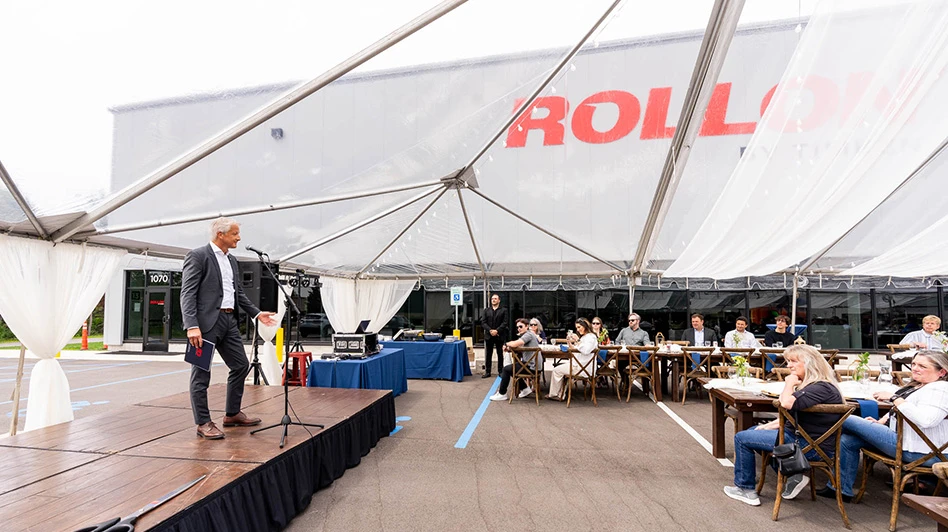
Oliver Dietze
Artificial muscles and nerves made from the shape memory alloy nickel-titanium are making robot arms as supple and agile as their animal counterparts. But these artificial limbs also weigh less, will work tirelessly and can be precisely controlled. The bionic robot arms that are being developed by Professor Stefan Seelecke's research team at Saarland University in collaboration with the German automation specialist Festoconsume very little electric power and can work safely with humans. The research team will be presenting the technology at this year’s Hannover Messe from April 17-21, 2023 (Hall 002, Stand B34).
Today's industrial robots are powerful, fast, and highly precise, but they are also heavy and potentially life-threatening. Anyone who works with these machines has to be careful, being struck by an industrial robot arm can have painful consequences. If people are to work side by side and hand in hand with robots, the robots will, quite literally, need to become softer. The research team led by Professor Stefan Seelecke, a specialist in intelligent material systems at Saarland University, is developing a robot arm that does not incorporate any heavy metal parts at all.
The researchers in Saarbrücken have drawn inspiration from the natural world, specifically, the elephant's trunk.
“The trunk of an elephant is an evolutionary success story that has had millions of years to adapt and to prove itself in practice,” Seelecke explains.
The slender trunk-like robotic arm that the research team is developing can swing, sway, and bend in all directions. Unlike the heavy, articulated metal arms used in today's industrial robots, the new robot arm is not attached to a bulky joint that only allows movement in certain directions. And just like an elephant's trunk contains no bones, the robotic trunk does not have any rigid metal framework. Its suppleness and maneuverability come from the clever way in which its artificial muscles interact with each other.
See what the team displayed at HANNOVER MESSE 2019.
“By using smart material systems, we are able to create bendable and soft robotic tools that are much lighter and much more flexible than the devices in use today. They don’t need to be driven by motors or by hydraulic or pneumatic systems – all they need is a little electric power. That makes our technology sustainable, cost-effective, and quiet,” Seelecke says.
His research group at Saarland University and at the Center for Mechatronics and Automation Technology in Saarbrücken (ZeMA) is developing different types of artificial muscles for use in smart robotic trunks and tentacles. The engineers make use of smart polymers and shape memory alloys when designing these systems. The team is showcasing a new prototype robotic trunk at this year's Hannover Messe. They will be demonstrating the capabilities of the 30cm-long proboscis whose muscles and nerves are made from nickel-titanium wire bundles.
“The technology we're developing is scalable and can be used in large robot arms for industrial applications,” Seelecke says.
Artificial muscles made from nickel-titanium wires can contract like the muscles in living organisms. They can, on command, be made shorter (muscle contraction) and then made longer again (muscle relaxation). The ability of nickel-titanium to behave in this way is because the alloy possesses the unusual property of shape memory, i.e. the material is able to remember its original shape and to return to it after being deformed. If a nickel-titanium wire is heated, for example by an electric current, it will become shorter. When the current is switched off, the wire cools down and returns to its original length. The reason for this behavior lies in the crystal structure of the alloy.
“Heating the alloy induces solid-state phase transitions,” explains Professor Paul Motzki, who conducts research with Seelecke and holds a cross-institutional professorship in the field of smart material systems for innovative production at Saarland University and ZeMA. Unlike liquid water, for example, which changes state and becomes gaseous when heated, nickel-titanium remains in the solid state, but its crystal structure undergoes a transformation.
The engineers construct the robotic trunk from a large number of artificial muscle strands. Just as human muscle tissue is made from bundles of muscle fibers, the artificial muscle strands comprise bundles of ultrafine shape-memory wires. These bundles of ultrathin wires provide a large surface area through which they can transfer heat, which means they cool down and relax more rapidly after contraction. And they're strong, too.
“The wires have the highest energy density of all known drive mechanisms and they can deliver a substantial tensile force. That enables us to build powerful drive technologies in very small spaces, something that would otherwise be impossible,” Motzki notes.
By threading the wire bundles through a series of round thin plastic discs, the wire bundles maintain the spacing between the discs, thus creating segments of the trunk-like structure. When they join several of these segments together, the researchers can build an entire trunk, with the size of the discs becoming smaller towards the tapered end of the trunk.
By applying electrical currents, the research team can flex the muscles in the trunk. Shortening the artificial muscle strands on one side of a muscle segment causes the trunk to bend outwards at the desired angle at that location. By controlling how the individual wire bundles are activated, the artificial muscles can be made to flex and extend to create flowing sequences of movements. Without any need for additional sensors, the researchers can thus control the position of the trunk quickly and precisely and thus make it perform almost any sequence of movements. Extra sensors are not needed because the artificial muscles themselves have sensory properties, which allows them to also act as a kind of internal nervous system.
“Every distortion of the wires causes a change in electrical resistance, which allows us to assign a precise resistance value to any specific deformation of the wire. Using these resistance values, we know exactly how a particular wire bundle is currently deformed, which essentially imparts sensory properties to the system,” explains doctoral student Yannik Goergen, who developed the artificial trunk as part of his doctoral research project. To train the bionic trunk, the engineers use these values to model and program movement sequences, which itself involves developing intelligent algorithms for this purpose. They can also equip the tip of the trunk with additional functions, such as a gripper tool or a camera system. The trunk could also be fitted with a hose that could precisely dispense or pump out fluids.
Background
The research work on the bionic trunk was carried out in collaboration with the Festo Group. This technology continues to be developed by PhD students who are conducting research as part of their doctoral dissertation projects. The results have been published as papers in a variety of scientific journals. The research work has also received support from numerous sources. For example, the German Research Foundation (DFG) has provided funding through the project DFG SPP 2100 Soft Materials Robotics and the Federal Ministry for Economic Affairs and Climate Action (BMWK) has funded the project AutoEndoskop – Inspection of Complex Components, Turbines, which is part of the federal innovation programme for medium-sized companies ZIM.
The company mateligent GmbH was spun off from Professor Seelecke's department to facilitate the transfer of the results of their applications-driven research to commercial and industrial applications.
Latest from Today's Medical Developments
- Discover the future of manufacturing at GROB's 5-AXIS LIVE!
- Revolutionizing quality control with Hexagon's Autonomous Metrology Suite
- Autocam Medical's $70 million expansion to boost orthopedic job creation
- Platinum Tooling unveils new product catalog
- Meet the minds shaping CNC grinding at The Precision Summit
- Mitutoyo unveils innovative SurfaceMeasure-S Series sensors
- #69 Manufacturing Matters - Shopfloor Connectivity Roundtable with Renishaw and SMW Autoblok
- Veeva's impact on compliance and efficiency in medtech







